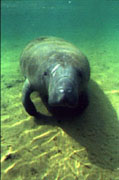|
 |
| Above picture
shows the manatee, "Joan", foraging for food on
the floor of the Alligator Hole River, Clarendon. |
For the past 18 years, three
adult female manatees have been living in an enclosed river
system known as the Alligator Hole River in Clarendon, Jamaica.
They were placed there as a rescue effort by the Natural Resources
Conservation Authority (NRCA). Each was accidentally caught
in the nets of fishermen off the Farquhar's Beach in Clarendon.
There were initially four manatees; the fourth manatee, also
a female, was pregnant at the time she was placed in the river,
and she died after giving birth. The offspring also died.
 |
The remaining manatees have
almost completely consumed the plants found in the river. Recently
they have started adding 'river
weed' to their daily diets, at a feeding area. This is a very
expensive programme, but if they stop, the manatees will die!
Since they have been separated from the already small and diminished
manatee population in the Jamaican waters, they have in total
missed at least 18 reproductive events. It is approximated that
three healthy 'sea cows' could have possibly carried six full
term pregnancies over an 18 year period!
Realizing this, a decision
has been made to prepare the manatees for release to the wild.
This has included the construction of a 'guillotine'
style trap/cage where the manatees
currently feed. They will be trapped in this cage just prior
to their release. The reintroduction of freshwater vegetation
and the "sinking" of sea grasses, will help to reacquaint
the manatees with eating food from the sea floor. During their
capture and release, data will be collected from them, and the
animals will be fitted with satellite tags and radio transmitters
for post release tracking and monitoring. The monitoring will
be done for a two year period, to see if the manatees will rejoin
the wild population, and also to see if they will be accepted
into a mating herd and eventually breed.
 |
| Picture
above shows blood being taken from a manatee. |
At the time of release,
blood, urine, stool and flesh samples will be taken from each
manatee, and an ultrasound fat analysis will also be done on
each. Each will be measured to get the correct length and girth
(distance around the animal); they will also be weighed individually.
 |
| Picture above shows
a diver in the process of building a cage which will be
used to trap the manatees for removal. |
|
|
|